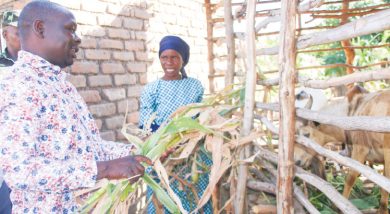Mtwalo struggles with respiratory infections
Residents in Mzimba are coming to terms with the sad reality that keeping the green gold, tobacco, in homes has a boomerang effect on their health. JOHN CHIRWA writes.
Malaria has been identified as a major health problem in Malawi. Ministry of Health estimated that six million cases occur annually, and the mosquito-borne infectious disease is cited as the leading cause of death in under-five children and pregnant women.
Surprisingly, in the area under Senior Chief Mtwalo in Mzimba North, malaria is the second on the ladder of diseases that plague the area.

Statistics at Mtwalo Health Centre indicate that the leading diseases are respiratory tract infections such as pneumonia and colds.
Between June and August this year, the clinic, with a catchment area of 11 998 people, recorded 2 083 such infections against 207 cases of malaria.
Such an irregular trend has left health authorities in the area with assumptions.

“It’s really difficult to give valid explanations for such an irregular trend. But it appears that tobacco farming is contributing to this situation because people here sleep with tobacco in their homes,” says the clinic’s officer-in-charge Ernest Makunganya.
The rise in respiratory infections in the area has had a negative impact on the clinic. Drug consignments meant for two months is depleted in two weeks.
“We receive 18 000 bactrim tablets for two months. But the challenge is that we have 298 individuals on anti-retroviral therapy [ART] who also depend on the same tablets. So, in two weeks such tablets are depleted, and we spend some weeks without drugs,” he says.
Evidence has shown that populations, especially children that are heavily exposed to wood smoke from cooking are at much higher risk from severe pneumonia and higher risk of mortality, according to The Lancet, a UK medical journal.
This is one of the reasons various organisations are advocating against child labour in tobacco estates because children’s encounter with nicotine, a chemical compound present in tobacco, exposes them to pneumonia and tuberculosis.
But in Mzimba, where tobacco is produced in abundance, tendencies of keeping tobacco in homes and on the veranda are widespread.
Kelvin Jere from Mtwalo says poverty and lack of security in his area forces him to live under the same roof with tobacco in a tiny grass thatched house.
One of the three bedrooms is reserved for storing tobacco although some of the tobacco is hanged on the veranda and living room.
“The shade I have is very small. I only use it for drying tobacco. But for grading and grouping I do it in my house,” he explains.
Jere says he prefers to grade and group his tobacco inside the house for the sake of security.
“Theft is rampant here. People would easily steal my tobacco if left in the shade after drying,” he says.
He says he also prefers to keep it in the house for the sake of maintaining its quality. He says if left in the shade, tobacco loses its quality due to the winds which dry the leaf further.
“Before baling, the leaf is supposed to be soft, and that is possible when we keep it in homes,” he says.
He, however, admits that there are instances that his children are affected by colds during periods he keeps tobacco in the home.
Acute respiratory infection is one of the most significant causes of illnesses and death amongst children worldwide.
In Malawi, between 2004 and 2010 the proportion of children with respiratory infections taken to a health facility for treatment increased from 19.6 percent to 70.3 percent although there was a reduction of pneumonia case fatality from 18.7 percent in 2000 to 5.7 percent in 2008, according the 2010 Malawi Demographic and Health Survey (DHS).
It is believed that successful implementation of pneumonia interventions in government’s Programme of Work (PoW) of 2004 to 2010 is likely to have contributed to the dramatic fall in infant and child mortality which is estimated at 33 deaths per 1 000 live births; although it is higher in rural areas at 34 deaths per 1 000 deaths compared to urban areas (30/1 000).
For the figures to reduce further, Foundation for Children’s Rights (FCR) programmes manager Kondwani Botha says rural areas need to have strong leadership structures to equip the people with relevant knowledge in behaviour or lifestyle change.
“Any problem that people in rural areas have has a health implication. So, the issue is: What are the local leaders doing to mitigate problems in their areas to make sure that such challenges do not exert pressure on the already fragile health economy?” he observes.
Botha says if local leaders have relevant knowledge on health issues then it would help prevent occurrences of such infections that come due to a negative lifestyle.
“The problem is that traditional leaders formulate bylaws against various life-threatening behaviour, but implementation is very minimal,” he argues.
At Mtwalo, as it appears, there are no interventions to fight such lifestyles that have put the health sector on the knife.





